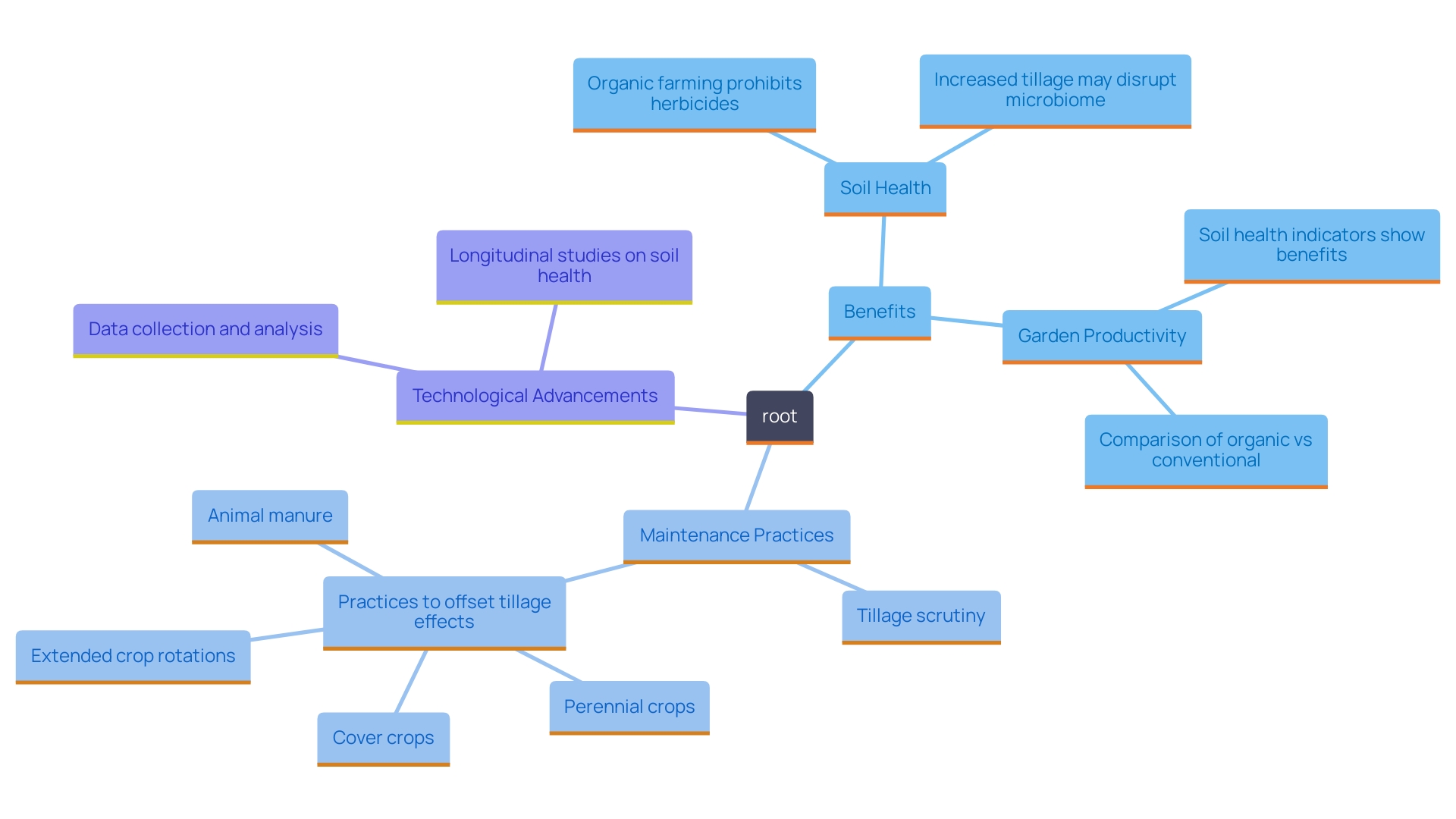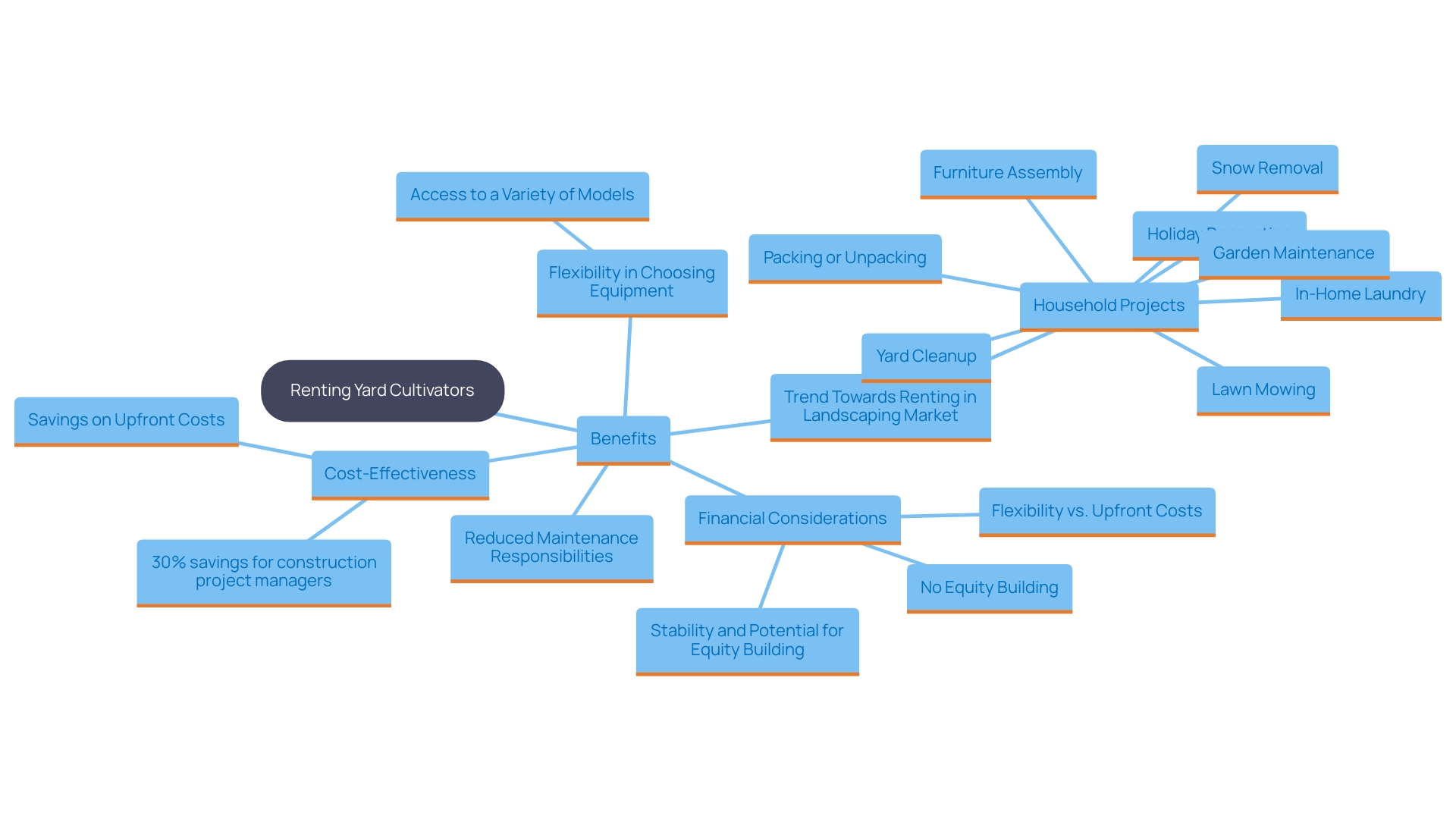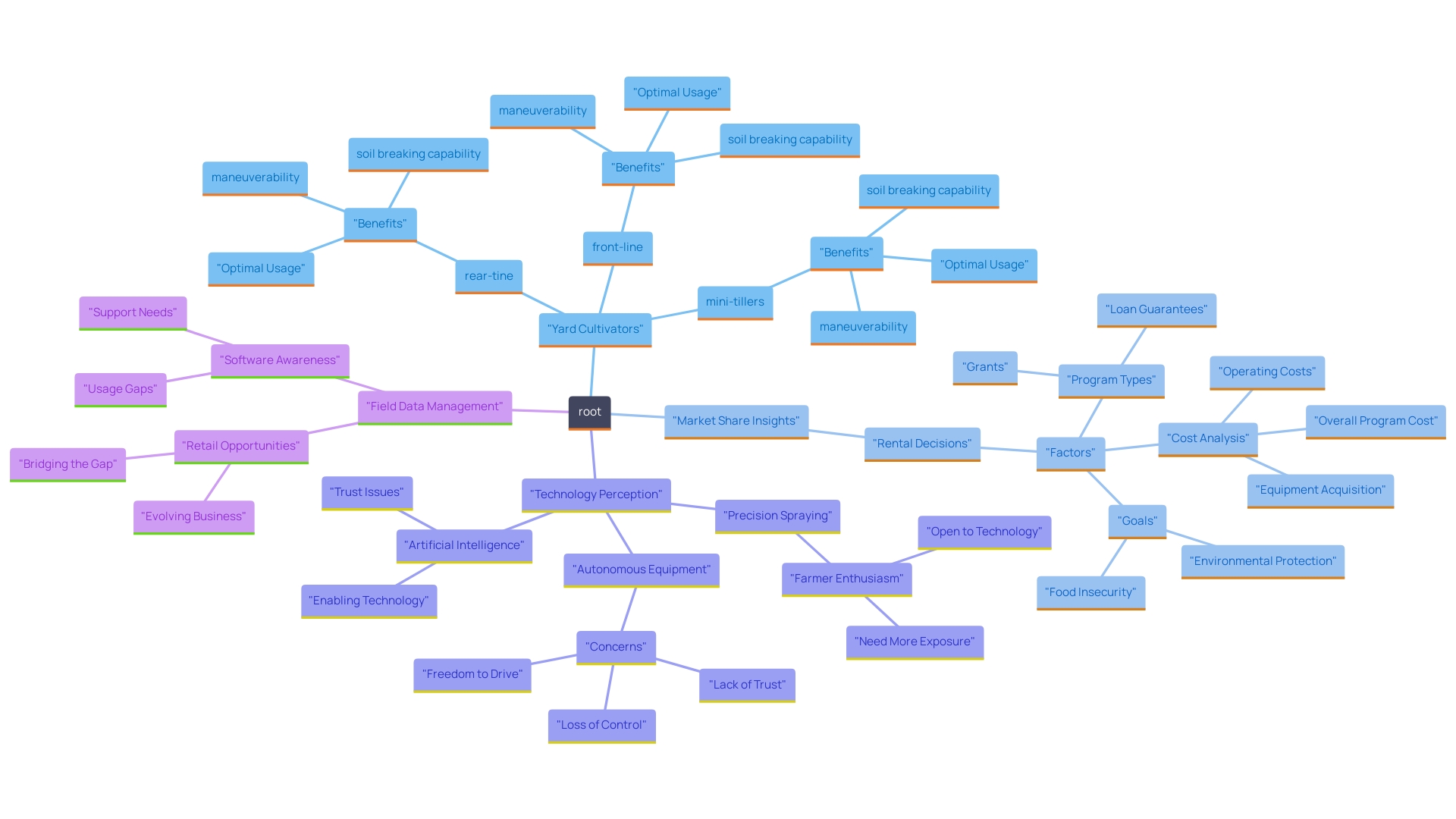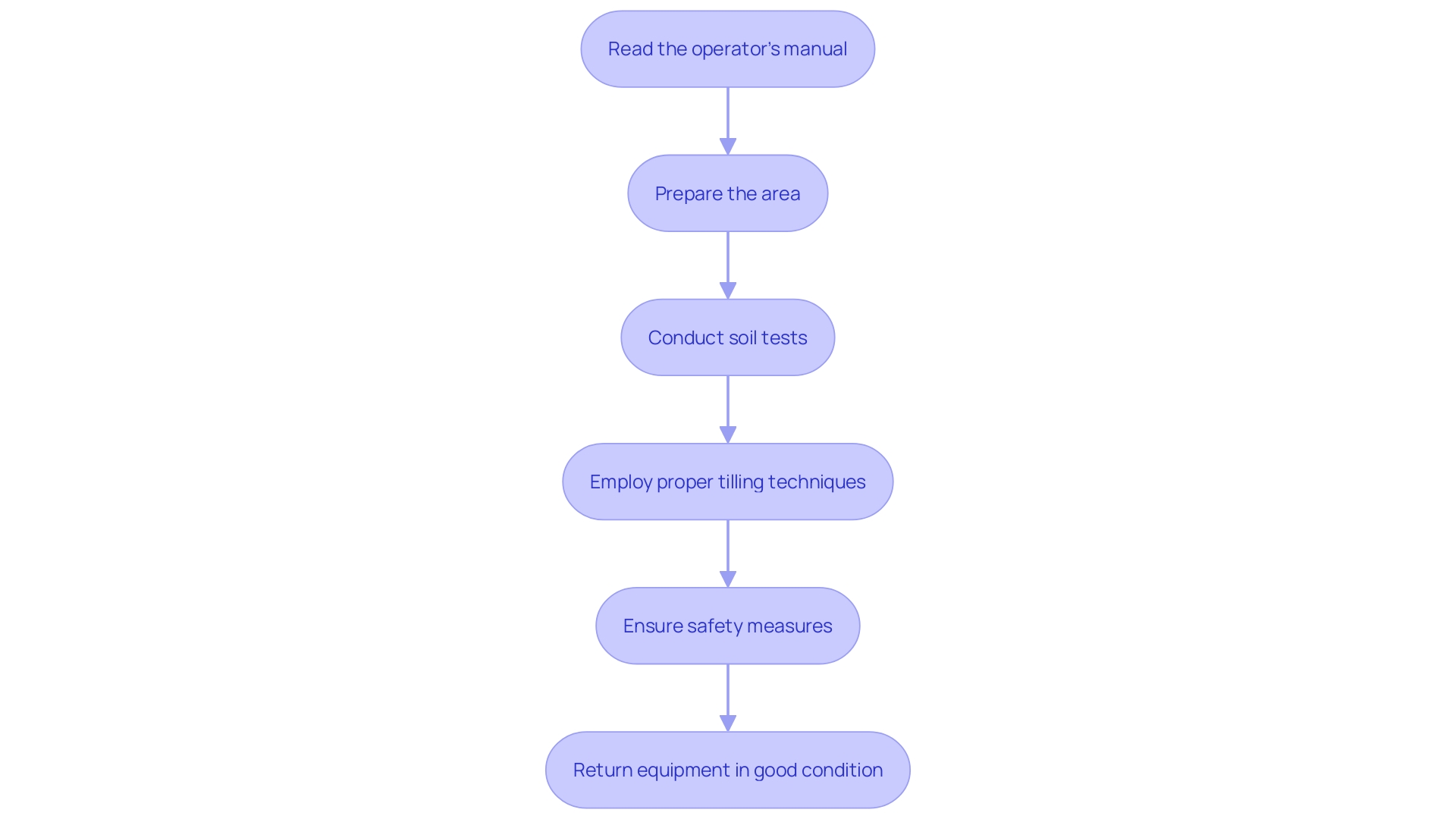Introduction
In the realm of gardening and landscaping, the right tools can make all the difference in achieving a thriving outdoor space. Yard tillers, often overlooked, play a pivotal role in preparing soil for planting, enhancing its structure, and improving nutrient absorption. As homeowners and landscapers grapple with the challenges of soil management, understanding the various types of tillers and their functionalities becomes essential.
From the cost-effective option of renting to best practices for usage, this article delves into the multifaceted benefits of yard tillers, equipping readers with the knowledge to elevate their gardening efforts and ensure bountiful harvests. Whether facing compacted earth or planning a new garden layout, the insights provided will guide users in making informed decisions that enhance their gardening experience.
Understanding Yard Tillers: Purpose and Functionality
Yard tillers, often known as cultivators or rotary tillers, are vital instruments for ground preparation before planting. These powerful machines utilize rotating blades to break up, churn, and mix the ground, significantly improving its structure and enhancing its capacity for water and nutrient absorption. This process is essential for homeowners and landscapers who need to for gardens or landscaping projects. According to recent studies, approximately 70% of gardeners indicate enhanced soil health due to the use of cultivators, emphasizing their significance in effective cultivation techniques.
Proper maintenance of the equipment is essential to minimize breakdowns and ensure longevity. Reimer emphasizes the importance of end-of-season care, such as draining the gas and running the engine dry to keep fuel lines clean. Similarly, Norcott highlights the practice of mixing small amounts of fuel to maintain freshness. By following these tips, users can prolong the lifespan of their equipment, ensuring reliable performance throughout their gardening activities.
For example, a recent initiative at a community plot demonstrated the efficiency of yard cultivators in converting compacted earth into productive land for planting. By using a yard cultivator, volunteers were able to prepare the planting areas in just a fraction of the time compared to manual methods, leading to a bountiful harvest that season.
Expert insights, like those from B & M Lawn & Garden, highlight the importance of yard tools in tackling weed issues without using herbicides. Furthermore, advancements in horticultural machinery technology, such as improved engine efficiency and ergonomic designs, have further enhanced their functionality, making them essential tools for both amateur and professional landscapers.
In summary, understanding the purpose and functionality of yard cultivation tools reveals their significant benefits for soil health and overall garden productivity. These tools not only facilitate healthier plant growth but also streamline cultivation efforts, making them more efficient and effective.

The Advantages of Renting Yard Tillers
Renting yard cultivators presents numerous advantages that can significantly simplify gardening and landscaping projects while being cost-effective. By choosing to rent, users avoid the hefty upfront costs associated with buying the equipment, which is particularly beneficial for those who use it infrequently. Additionally, rental agreements typically encompass maintenance and support, allowing users to focus solely on their projects without the burden of equipment upkeep.
Moreover, renting offers the and sizes, ensuring that users can select the ideal equipment for their specific needs without the long-term commitment of ownership. This adaptability is especially valuable for occasional gardeners and those involved in larger landscaping endeavors.
Statistics indicate that renting helps minimize fleet size, reducing storage, maintenance, and operational costs. For companies, this results in considerable savings; for example, a construction project manager can save up to 30% in equipment expenses by opting to rent machinery instead of buying them outright. As Trinity Power aptly states, 'Count on Trinity Power for turnkey solutions, expert service, and access to an extensive generator rental inventory.'
A compelling case study titled 'Minimize Your Fleet' exemplifies this benefit. It illustrates how managing a large fleet of equipment can lead to increased costs and complexities, whereas renting enables businesses to optimize fleet size, reduce storage and maintenance costs, and ensure the availability of the right equipment for each job.
Furthermore, the current trend in the rental market for landscaping equipment underscores a growing preference for renting over buying. This shift is driven by the cost-effectiveness and convenience that renting provides. For example, by leasing a cultivator for a one-time project, users can reduce maintenance and storage expenses, making it a sensible option for both home planting and professional landscaping endeavors. In conclusion, the financial and operational benefits of renting yard equipment make it an appealing solution for various gardening needs.

Types of Yard Tillers Available for Rent
When exploring , it's essential to understand the various types available and their specific benefits. Rear-tine cultivators, which come in configurations like CRT, SRT, and DDT, are particularly powerful and well-suited for larger planting areas and breaking up tough soil. These cultivators are highly effective but tend to be heavier and more challenging to maneuver around small plants, which can be a disadvantage, especially in tighter gardening areas. Moreover, they generally come at a higher rental cost.
In contrast, front-line cultivators provide greater maneuverability, making them ideal for smaller garden spaces and home gardens. Their ability to prepare seed beds effectively is well-documented, although they are less capable of breaking new ground compared to their rear-tine counterparts. As expert Emily Caudill emphasizes, 'Understanding these three components will help you make an informed decision when selecting your equipment, providing you with the best tilling solution for your project and your budget.'
For light-duty tasks, such as cultivating flower beds or small vegetable patches, mini-tillers are the optimal choice. These compact and lightweight cultivators are designed to handle less intensive gardening challenges efficiently.
Case studies reveal that while front-line cultivators are advantageous for their larger frame and deeper tilling capabilities, they may not be the best option for breaking new ground. For example, a recent study comparing the performance of rear-tine and front-tine cultivation tools in a community garden setting found that rear-tine models outperformed front-tine variants in tougher soil conditions, offering deeper soil penetration and more efficient soil aeration. This insight allows users to weigh strengths and limitations effectively, ensuring they select the right equipment for their specific gardening needs. By understanding the unique features and benefits of each type of cultivator, along with the market share statistics showing that rear-tine models account for approximately 60% of rental transactions in the last year, users can make well-informed rental decisions that align with their project requirements.

Best Practices for Renting and Using Yard Tillers
To maximize the efficiency of rented yard cultivators, adhering to best practices is essential. Start by thoroughly reading the operator’s manual to familiarize yourself with the unique features and safety measures of the equipment. For instance, Orec's GardenQuake tiller includes a differential lock, which aids in maintaining straight lines and easier control during tilling.
Before starting, clear the area of rocks, debris, and large roots to prevent interruptions. When tilling, use such as overlapping passes and adjusting the depth according to ground conditions. These methods ensure you achieve the best results. Additionally, conducting a ground test can be beneficial; acquiring a testing kit is affordable and can help you assess nutrient levels. To perform a soil test, collect samples from different areas of your garden, mix them, and follow the kit instructions for accurate analysis.
Safety is paramount when operating yard equipment. Always wear protective gear, including gloves, goggles, and sturdy footwear. Ensure that bystanders are at a safe distance when operating the equipment to prevent accidents. Familiarize yourself with the equipment's controls and practice operating it in a safe area before tackling larger tasks.
Properly amending your soil and incorporating it with the cultivator can significantly enhance your plants' health, as noted by experts at Orec America. Finally, ensure the equipment is returned in good condition to avoid extra fees and facilitate a seamless rental process for future projects. By following these guidelines, you can effectively utilize tillers and achieve optimal outcomes in your gardening tasks, enhancing the overall health and productivity of your garden.

Conclusion
Utilizing yard tillers is a transformative step for anyone looking to enhance their gardening or landscaping efforts. These powerful tools not only improve soil structure and nutrient absorption but also save time and effort in preparing garden beds. Whether choosing to rent or purchase, understanding the various types of tillers—such as rear-tine, front-tine, and mini-tillers—ensures that users can select the right equipment tailored to their specific needs.
Renting yard tillers offers significant advantages, including cost savings and flexibility, making it an ideal option for occasional gardeners or larger projects. The ability to access a range of models without the burden of maintenance further supports effective gardening practices. By following best practices for usage, such as reading the operator's manual, preparing the area properly, and adhering to safety guidelines, users can maximize their tilling efficiency and ensure a successful gardening experience.
Incorporating yard tillers into gardening routines leads to healthier soil and more productive gardens. As homeowners and landscapers face the challenges of soil management, these tools emerge as essential allies in achieving lush, thriving outdoor spaces. Embracing the benefits of yard tillers can ultimately lead to bountiful harvests and a more fulfilling gardening journey.
Frequently Asked Questions
What are yard tillers and what purpose do they serve?
Yard tillers, also known as cultivators or rotary tillers, are essential tools for ground preparation before planting. They use rotating blades to break up, churn, and mix the soil, improving its structure and enhancing its capacity for water and nutrient absorption.
How do yard tillers benefit soil health?
Approximately 70% of gardeners report improved soil health due to the use of cultivators, highlighting their importance in effective cultivation techniques.
What maintenance practices are recommended for yard tillers?
Proper maintenance includes draining the gas and running the engine dry at the end of the season to keep fuel lines clean, as well as mixing small amounts of fresh fuel to maintain its quality.
How can yard tillers improve gardening efficiency?
For instance, a community initiative showed that using yard cultivators allowed volunteers to prepare planting areas much faster than manual methods, resulting in a successful harvest.
What advancements have been made in yard tiller technology?
Recent advancements include improved engine efficiency and ergonomic designs, making yard tillers more effective and user-friendly for both amateur and professional landscapers.
What are the advantages of renting yard cultivators?
Renting yard cultivators allows users to avoid high upfront costs, benefit from maintenance support, and choose from a variety of models and sizes without long-term commitments, making it a cost-effective option.
What types of yard cultivators are available for rent?
There are several types of yard cultivators, including rear-tine cultivators, which are powerful and suitable for larger areas, and front-line cultivators, which offer better maneuverability for smaller spaces. Mini-tillers are also available for light-duty tasks.
What should users consider when selecting a yard cultivator?
Users should consider the specific gardening tasks they need to accomplish, as rear-tine cultivators are better for tough soil conditions, while front-line cultivators are ideal for seed bed preparation in smaller gardens.
What best practices should be followed when using rented yard cultivators?
Best practices include reading the operator’s manual, clearing the area of debris, using proper tilling techniques, conducting soil tests, wearing protective gear, and ensuring the equipment is returned in good condition.
How can soil amendment enhance plant health when using a cultivator?
Properly amending the soil and incorporating it with the cultivator can significantly improve the health of plants, as noted by experts in the field.




